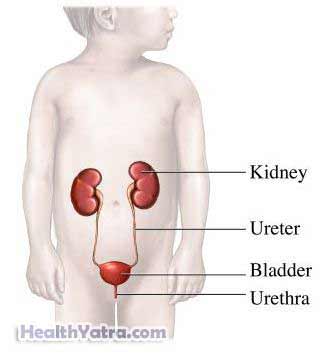Definition
The urinary tract carries urine from the kidneys to the outside of the body. It includes the kidneys, bladder, and tubes that connect them. The tubes from the kidney to bladder are called ureters. The tube from the bladder to the outside of the body is called the urethra. A urinary tract infection (UTI) is an infection in any of these structures.

Causes
UTIs are caused by bacteria. The bacteria may enter the bladder or the kidneys.
Risk Factors
Factors that may increase your child’s chance of developing a urinary tract infection include:
- Abnormalities of the urinary tract, including:
- Vesicoureteral reflux —urine flows backwards from the bladder up into the kidneys
- Urinary obstruction—something is blocking or slowing the flow of urine
- Holding urine for long periods of time
- Not fully emptying the bladder
- Poor hygiene and toilet habits
- Clothing that is too tight, especially if it is not cotton
- Family history of UTIs
- Uncircumcised penis
Symptoms
Symptoms include:
- Feeling the need to urinate frequently
- Only producing a small amount of urine
- Burning or painful urination
- Fever
- Diarrhea
- Irritability
- Fatigue
- Stomachache
- Foul-smelling urine
- Blood in the urine
- Potty-trained children wetting themselves
Diagnosis
The doctor will ask about your child’s symptoms and medical history. A physical exam will be done. The doctor may also ask for a urine sample. Follow your doctor’s directions on collecting your child’s urine.
Your child’s bodily fluids may need to be tested. This can be done with:
- Urinalysis—a laboratory examination of a urine sample
- Urine culture —to identify the specific bacteria that is involved
- Complete blood count and other blood tests if your child has a fever
Imaging tests may be ordered if your child is a boy with a UTI or a girl after her second UTI. These infections may be associated with problems in the urinary tract. The test may include ultrasound or specialized scans and x-rays.
Treatment
Talk with your doctor about the best treatment plan for your child. Treatment options include:
Antibiotics
Antibiotics will help fight the bacteria that is causing the infection. Your child will most likely be given antibiotic pills or liquid to take by mouth. Finish the medication even if your child is feeling better.
Some severe infections may need to have antibiotics delivered by IV or an injection.
Fluids
Encourage your child to drink plenty of fluids. This will help to flush the bacteria out of the system. It will also decrease the concentration of the urine. This may make it more comfortable to urinate.
Pain and Fever Relief
UTIs can be uncomfortable and may cause fever. Your doctor may recommend some over-the-counter medication for your child. They may include:
- Acetaminophen
- Ibuprofen
Follow the instructions on the package.
Note: Aspirin is not recommended for children or teens with a current or recent viral infection. This is because of the risk of Reye’s syndrome. Ask your doctor which other medicines are safe for your child.
Pyridium may also be prescribed. It helps relieve pain associated with UTIs.
If your child is diagnosed with a UTI, follow your doctor’s instructions .
Prevention
To help reduce your child’s chances of developing a urinary tract infection, take the following steps:
- Talk to your child’s doctor if your child has an abnormality of the urinary system. Your child may need surgery.
- Make sure that girls learn to wipe from front to back.
- Encourage your child to go to the bathroom often—at least several times a day.
- Retract the foreskin of the penis on a regular basis. This will help to keep the area clean.
- If your child has UTIs often, the doctor may prescribe antibiotics. This may help to prevent a new infection.
